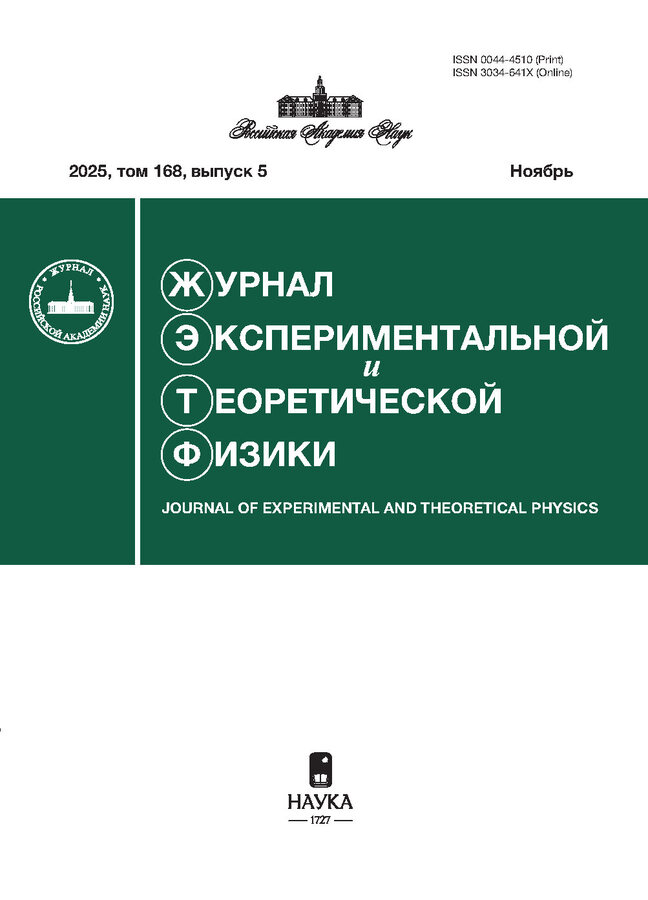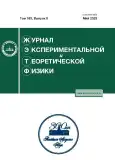Influence of Structural Parameters on the Electronic Structure of Topological Surface States in MnBi2Te4
- Authors: Makarova T.P1, Shikin A.M1, Eryzhenkov A.V1, Tarasov A.V1
-
Affiliations:
- St. Petersburg State University
- Issue: Vol 163, No 5 (2023)
- Pages: 708-716
- Section: Articles
- URL: https://journals.rcsi.science/0044-4510/article/view/145408
- DOI: https://doi.org/10.31857/S0044451023050097
- EDN: https://elibrary.ru/BENYOQ
- ID: 145408
Cite item
Full Text
Abstract
Experimental investigations of antiferromagnetic topological insulator MnBi2Te4 have shown that the energy gap in samples may vary in a wide range. Since the energy gap is a key parameter of this system when used in developing new functional electronic devices, the reason for variation of the MnBi2Te4 energy gap at the Dirac point and its possible interrelation with magnetic interactions are matters of great importance and call for thorough analysis. To elucidate factors influencing the energy gap, we analyzed the variation of the electronic structure of the given topological insulator with surface van der Waals gap. Calculation data have shown that the energy gap at such structure modifications may vary in a wide range from 80–88 meV to 4–5 meV because of an intense spatial redistribution of topological surface states between septuple-layer MnBi2Te4 blocks with oppositely directed Mn magnetic moments. Our results suggest that the spatial localization of topological surface states is a primary factor governing the value of the energy gap, this localization being strongly dependent on structure modifications on the crystal surface.
About the authors
T. P Makarova
St. Petersburg State University
Email: i@tmakarova.ru
198504, St. Petersburg, Russia
A. M Shikin
St. Petersburg State University
Email: i@tmakarova.ru
198504, St. Petersburg, Russia
A. V Eryzhenkov
St. Petersburg State University
Email: i@tmakarova.ru
198504, St. Petersburg, Russia
A. V Tarasov
St. Petersburg State University
Author for correspondence.
Email: i@tmakarova.ru
198504, St. Petersburg, Russia
References
- X.-Li. Qi, T. L. Hughes, and S.-C. Zhang, Phys. Rev. B 78, 195424 (2008).
- X.-L. Qi and S.-C. Zhang, Rev. Mod. Phys. 83, 1057 (2011).
- C.-Z. Chang, J. Zhang, X. Feng et al., Science 340, 167 (2013).
- Y. Tokura, K. Yasuda, and A. Tsukazaki, Nature Rev. Phys. 1, 126 (2019).
- C. Z. Chang, W. Zhao, D. Kim et al., Nature Mater. 14, 473 (2015).
- M. Gibertini, M. Koperski, A. F. Morpurgo et al., Nature Nanotechn. 14, 408 (2019).
- K. Burch, D. Mandrus, and J.-G. Park, Nature 563, 47 (2018).
- X. Lin, W. Yang, K. L. Wang et al., Nature Electron. 2, 274 (2019).
- T. Jungwirth, X. Marti, P. Wadley et al., Nature Nanotechn. 11, 231 (2016).
- L. Sˇmejkal., Y. Mokrousov, B. Yan et al., Nature Phys. 14, 242 (2018).
- V. Baltz, A. Manchon, M. Tsoi et al., Rev. Mod. Phys. 90, 015005 (2018).
- Y. Deng, Y. Yu, M. Z. Shi et al., Science 367, 895 (2020).
- A. Essin, J. Moore, and D. Vanderbilt, Phys. Rev. Lett. 102, 146805 (2009).
- S. Coh, D. Vanderbilt, A. Malashevich et al., Phys. Rev. B 83, 085108 (2011).
- S.-Y. Xu, M. Neupane, C. Liu et al., Nature Phys. 8, 616 (2012).
- Y. L. Chen, J. H. Chu, J. G. Analytis et al. Science 329, 659 (2010).
- J. G. Checkelsky, J. Ye, Y. Onose et al., Nature Phys. 8, 729 (2012).
- A. M. Shikin, A. A. Rybkina, D. A. Estyunin et al., Phys. Rev. B 97, 245407 (2018).
- A. M. Shikin, D. A. Estyunin, Yu. I. Surnin et al., Sci. Rep. 9, 4813 (2019).
- J. Henk, A. Ernst, S. V. Eremeev et al., Phys. Rev. Lett. 108, 206801 (2012).
- M. M. Otrokov, I. I. Klimovskikh, H. Bentmann et al., Nature 576, 416 (2019).
- D. Zhang, M. Shi, T. Zhu et al., Phys. Rev. Lett. 122, 206401 (2019).
- J. Li, Y. Li, S. Du et al., Science Advances 5, eaaw5685 (2019).
- Y. Gong, J. Guo, J. Li et al., Chin. Phys. Lett. 36, 076801 (2019).
- S. H. Lee, Y. Zhu, Y. Wang et al., Phys. Rev. Res. 1, 012011 (2019).
- Z. S. Aliev, I. R. Amiraslanov, D. I. Nasonova et al., J. Allows Comp. 789, 443 (2019).
- M. M. Otrokov, I. P.Rusinov, M. Blanco-Rey et al., Phys. Rev. Lett. 122, 107202 (2019).
- C. Liu, Y. Wang, H. Li et al., Nature Mater. 19, 522 (2020).
- J. Ge, Y. Liu, J. Li et al., Nat. Sci. Rev. 7, 1280 (2020).
- A. Gao, Y.-F. Liu, C. Hu et al., Nature 595, 52 (2021).
- А. М. Шикин, Д. А. Естюнин, Н. Л. Зайцев и др., ЖЭТФ 161, 126 (2022).
- D. A. Estyunin, I. I. Klimovskikh, A. M. Shikin et al., Appl. Phys. Lett. Mater. 8, 021105 (2020).
- A. M. Shikin, D. A. Estyunin, I. I. Klimovskikh et al., Sci. Rep. 10, 1 (2020).
- A. M. Shikin, D. A. Estyunin, N. L. Zaitsev et al., Phys. Rev. B 104, 115168 (2021).
- Y.-J. Hao, P. Liu, Y. Feng et al., Phys. Rev. X 9, 041038 (2019).
- Y. J. Chen, L. X. Xu, J. H. Li et al., Phys. Rev. X 9, 041040 (2019).
- P. Swatek, Y. Wu, L. L. Wang et al., Phys. Rev. B 101, 161109 (2020).
- D. Nevola, H. X. Li, J.-Q. Yan et al., Phys. Rev. Lett. 125, 117205 (2020).
- C. Yan, S. Fernandez-Mulligan, R. Mei et al., Phys. Rev. B 104, L041102 (2021).
- B. A. Bernevig, C. Felser, and H. Beidenkopf, Nature 603, 41 (2022).
- M. Garnica, M. M. Otrokov, P. C. Aguilar et al., Quant. Mater. 7, 1 (2022).
- А. М. Шикин, Д. А. Естюнин, Д. А. Глазкова и др., Письма ЖЭТФ 115, 241 (2022).
- S. Grimme, J. Antony, S. Ehrlich et al., J. Chem. Phys. 132, 154104 (2010).
- N. Troullier and J. L. Martins, Phys. Rev. B 43, 1993 (1991).
- T. Ozaki, Phys. Rev. B 67, 155108 (2003).
- T. Ozaki and H. Kino, Phys. Rev. B 69, 195113 (2004).
- T. Ozaki and H. Kino, Phys. Rev. B 72, 045121 (2005).
- J. P. Perdew, K. Burke, and M. Ernzerhof, Phys. Rev. Lett. 77, 3865 (1996).
- M. J. Han, T. Ozaki, and J. Yu, Phys. Rev. B 73, 045110 (2006).
Supplementary files










